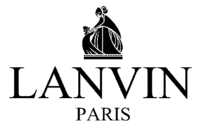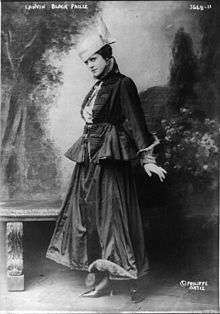Lanvin (company)
Lanvin (French: [lɑ̃vɛ̃]) is a French multinational high fashion house, which was founded by Jeanne Lanvin in 1889. It is the third oldest French fashion house still in operation. In 1990, the house was taken over by the Orcofi Group, then sold to l’Oréal in 1996. In 2001, Shaw-Lan Wang, a Taiwanese media magnate, took Lanvin private again. On 14 March 2016, Bouchra Jarrar was appointed as Creative Director for Women’s Collection, replacing Alber Elbaz, who had transformed the company over the previous fourteen years. Ms. Bouchra's departure was announced on 6 July 2017. She was succeeded as artistic director by Olivier Lapidus, who left the company without a named successor on 22 March 2018. Men’s Collections have been headed by Lucas Ossendrijver since 2005.
 | |
| Private company | |
| Industry | Fashion |
| Founded | 1889 |
| Founder | Jeanne Lanvin |
| Headquarters | , |
Area served | Worldwide |
Key people | Michele Huiban (CEO) Olivier Lapidus (Designer, women's collections) Lucas Ossendrijver (Designer, men's collections) |
| Products | Apparel, accessories, perfume, jewelry |
| Parent | Harmonie S.A. |
| Website | lanvin |
| Footnotes / references [1] | |
History

Lanvin made clothes for her daughter, Marie-Blanche de Polignac, which began to attract the attention of a number of wealthy people, who requested copies for their own children. Soon, Lanvin was making dresses for their mothers,[2] and some of the most famous names in Europe were included in the clientele of her new boutique on the rue du Faubourg Saint-Honoré, Paris. In 1909, Lanvin joined the Syndicat de la Couture, which marked her formal status as a couturière. The Lanvin logo was inspired by a photograph taken for Jeanne Lanvin as she attended a ball with her daughter wearing matching outfits in 1907.[2]
From 1923, the Lanvin empire included a dye factory in Nanterre.[3] In the 1920s, Lanvin opened shops devoted to home decor, menswear, furs and lingerie, but her most significant expansion was the creation of Lanvin Parfums SA in 1924. "My Sin", an animalic-aldehyde based on heliotrope, was introduced in 1925, and is widely considered a unique fragrance. It would be followed by her signature fragrance, Arpège, in 1927, said to have been inspired by the sound of her daughter's practising her scales on the piano.
Jeanne Lanvin was one of the most influential designers of the 1920s and 1930s. Her use of intricate trimmings, virtuoso embroideries and beaded decorations in clear, light, floral colors became a Lanvin trademark.
After Jeanne Lanvin
When Lanvin died in 1946, ownership of the firm was ceded to her daughter Marguerite,[4] who had shared management of the firm from 1942 with a cousin and then a fashion-industry expert. Because Marie-Blanche de Polignac was childless when she died in 1958, the ownership of the House of Lanvin went to a cousin, Yves Lanvin.
From mid-1960's through to the 1996 takeover by L'Oreal, Lanvin was run by Bernard Lanvin. The export department was in the original factory in Nanterre where all the perfumes were made and bottled. The administrative Head Office was in Paris at 3, Rue de Tilsitt. In 1979, Lanvin bought its independence from Squibb USA and a major PR promotional tour was arranged by Paris in the United States in the same year.
Britain Midland Bank bought a stake in the company from the family in March 1989, and installed Léon Bressler to revamp the firm's faded image. However, in February 1990, Midland backed out and sold Lanvin to Orcofi, a French holding company led by the Vuitton family. From Orcofi, 50% of the House of Lanvin was acquired by L'Oréal in 1994, 66% in 1995 and 100% in 1996. Under L'Oréal's diverse umbrella, an array of CEOs who circulate within the French fashion industry have directed the company.
In August 2001, Lanvin [5] was taken private again by investor group Harmonie S.A., headed by Mrs. Shaw-Lan Wang, a Taiwanese media magnate.[5] In 2005, Joix Corporatic was the Lanvin ready-to-wear license holder in Japan with retail value of €50 million.[6]
On December 4, 2009, Lanvin opened their first US boutique in Bal Harbour, Florida.[7]
In 2011, Lanvin sales reached €203 million, not counting an estimated €4.5 million in revenues from licences.[5]
On November 20, 2013, Lanvin became the official tailor of Arsenal FC, a London-based football club.[8]
On October 28, 2015, Lanvin announced that Elbaz was no longer at the company, due to differences of opinion with the shareholders. He was replaced by Bouchra Jarrar in March 2016. Jarrar left the following year and was succeeded by Olivier Lapidus, who departed on 23 March 2018, after only two seasons. Lapidus' successor was not named upon his exit.
Creative directors since 2001
Alber Elbaz
In October 2001, Alber Elbaz was appointed the Lanvin artistic director for all activities, including interiors. In 2006, he introduced new packaging for the fashion house, featuring a forget-me-not flower color, Lanvin's favorite shade which she purportedly saw in a Fra Angelico fresco (Suzy Menkes, 2005.). On September 2, 2010, it was announced by H&M that Lanvin would be their guest designer collaboration for the Winter 2010 collection.[5] The collection would be available to view beginning November 4, 2010 at HM.com. The collection would then be available to buy in 200 stores worldwide, on November 20, with a first look sale the day before exclusively at the H&M store in Las Vegas.[9] The main face of the collection video was supermodel Natasha Poly [10]
Lucas Ossendrijver

Lucas Ossendrijver started with Kenzo’s menswear in 1997. In 2000, he moved to Munich where fashion designer Kostas Murkudis gave him free rein over the men’s line. Back in Paris, he then spent four years with Hedi Slimane at Dior Homme: his luxury fashion debut. In 2006, Lucas Ossendrijver was appointed the head of the men's line. The 2006 men's ready-to-wear collection was inspired by a Jean-Luc Godard film. He launched the first LANVIN urban sneakers, now with their patent leather toe caps, while presenting his AW 2006 collections; the shoes later became available in women’s collections. While enjoying a revitalized reputation in luxury, Lanvin received mainstream press in the United States in May 2009 when Michelle Obama was photographed wearing a popular line of Lanvin's sneakers made of suede with grosgrain ribbon laces and metallic pink toe caps while volunteering at a Washington, D.C. food bank. The sneakers were reportedly retailed at $540.[11] He designs the new Lanvin silhouette inspired by 90 years of tailoring heritage and sartorial know-how. He modernizes the shapes using innovative or noble fabrics like silk, the cuts are less strict and more fluid to match the contemporary tastes.
Bouchra Jarrar
Bouchra Jarrar was appointed as Creative Director by Lanvin in March 2016.[12] She is a Permanent Member of the French Chambre Syndicale de la Couture since 2014, she was a Guest Member as of January 2010. She worked as Nicolas Ghesquière’s studio director at Balenciaga for 10 years. In 2006, she moved on to French couture house Christian Lacroix — working alongside the designer as director of haute couture until the company closed in 2009. She founded her own house in 2010 and earned the official Haute Couture appellation in 2013.
In 2017 and with the preparation of only two ready-to-wear collections, Jarar stepped down from her position.[13] Upon her departure, Lanvin released the following statement : "Lanvin and Bouchra Jarrar have mutually decided to put an end to their collaboration".[14]
Bruno Sialelli
The 31-year-old French designer, Bruno Sialelli, was named the new creative director of Lanvin in January 2019.[15] Lanvin revealed in a statement that Sialelli's appointment marks a "pivotal new direction".[16] In less than 5 years, Lanvin has had 5 creative directors, including Olivier Lapidus, who left in 2018. Sialelli had worked with Jonathan Anderson at Spanish brand Loewe prior to the appointment and was presumed to be facing "great pressure to turn things around for the maison."[17]
Directors
- 1946–1950, Lanvin's daughter Marie-Blanche de Polignac, owner and director
- 1942–50, Marie-Blanche's cousin Jean Gaumont-Lanvin (Colombes, 1908–Versailles, 1988), director general
- 1950–1955, Daniel Gorin (Paris, 1891–Paris, 1972), director general
- 1959, Marie-Blanche's cousin Yves Lanvin, owner; Madame Yves Lanvin, president.
- 1989–1990, Léon Bressler, chairperson
- 1990–1993, Michel Pietrini, chairperson
- 1993–1995, Loïc Armand, chairperson
- 1995–2001, Gérald Asaria, chairperson
- 2001–2004, Jacques Lévy, director general
Designers
- 1946–1958: Marie-Blanche de Polignac, director general and designer
- 1950–1963: Antonio del Castillo, women's collections
- 1960–1980: Bernard Devaux, hats, scarves, haute couture; women's "Diffusions" line 1963–1980,
- 1964–1984: Jules-François Crahay (Liège, 1917–1988), haute couture collections and "Boutique de Luxe"
- 1972: Christian Benais, men's ready-to-wear collection
- 1976–1991: Patrick Lavoix, men's ready-to-wear collections
- 1981–1989: Maryll Lanvin, ready-to-wear, first haute couture in 1985 and women's "Boutique" collections
- 1989–1990: Robert Nelissen, women's ready-to-wear collections
- 1990–1992: Claude Montana, five haute-couture collections
- 1990–1992: Eric Bergère, women's ready-to-wear collections
- 1992–2001: Dominique Morlotti, women's and men's ready-to-wear collections
- 1996–1998: Ocimar Versolato, women's ready-to-wear collections
- 1998–2002: Cristina Ortiz, women's ready-to-wear collections
- 2002–2015: Alber Elbaz, artistic director of all creative activities
- 2003–2006: Martin Krutzki, designer of men's ready-to-wear
- 2006–present: Lucas Ossendrijver, men's collections
- 2016–2017: Bouchra Jarrar, women's collections
- 2017–2018: Olivier Lapidus, women's collections
References
- "Jeanne Lanvin S.A.: Private Company Information - Businessweek". Investing.businessweek.com. Retrieved 2013-09-16.
- "The Heart-warming History of the Lanvin Logo". Harper's BAZAAR. 2014-05-21. Retrieved 2017-09-23.
- "History of Haute Couture: Jeanne Lanvin". History of Fashion. 2011-11-05. Retrieved 2017-09-23.
- "Lanvin life". The Economist. Retrieved 2017-09-23.
- Pilling, David (February 17, 2012). "Lunch with the FT: Shaw-Lan Wang". Financial Times. Retrieved 10 July 2013.
- Chevalier, Michel (2012). Luxury Brand Management. Singapore: John Wiley & Sons. ISBN 978-1-118-17176-9.
- "Lanvin Opens in Bal Harbour - Designer/Luxury - Retail". WWD.com. 2009-12-09. Retrieved 2013-09-16.
- "Arsenal welcomes Lanvin". Arsenal.com. 2013-11-20. Retrieved 2013-11-20.
- Drop whatever you are doing, Lanvin is coming to L.A. - The Daily Truffle - November 8, 2010 Archived December 22, 2010, at the Wayback Machine
- "Lanvin for H&M - The Show (Promo 2011)". YouTube. 2010-11-02. Retrieved 2013-09-16.
- "First Lady Michelle Obama steps out in Lanvin sneakers and they're only $540!". NY Daily News. 2009-05-01. Retrieved 2013-09-16.
- "Lanvin Confirms Bouchra Jarrar As Artistic Director". Retrieved 2017-09-23.
- Paton, Elizabeth (2017-07-06). "Bouchra Jarrar, Artistic Director at Lanvin, Is Out After 16 Months". The New York Times. ISSN 0362-4331. Retrieved 2017-09-23.
- "Bouchra Jarrar Is Leaving Lanvin". Vogue. Retrieved 2017-09-23.
- Newbold, Alice. "Bruno Sialelli Named As Lanvin's New Creative Director". British Vogue. Retrieved 2019-02-01.
- Friedman, Vanessa (2019-01-21). "A New Designer Is Named to Reinvent Lanvin". The New York Times. ISSN 0362-4331. Retrieved 2019-02-01.
- "Loewe's Bruno Sialelli Becomes Lanvin New Creative Director". Humble & Rich Boutique.
- Lanvin (company) – brand and company profile at Fashion Model Directory